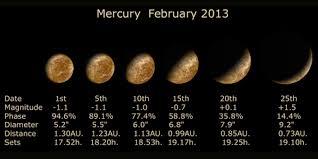
NavList:
A Community Devoted to the Preservation and Practice of Celestial Navigation and Other Methods of Traditional Wayfinding
From: Brad Morris
Date: 2019 Jan 30, 13:28 -0500
You wrote:
"Attached find a much better candidate image. It shows the phases of Mercury."No. I'm confident that you'll find that this image is output from a simulation, digital artwork, not photography. But that makes the point... It's quite difficult to see Mercury as a thin crescent. Don't get me wrong: it has been done.. somewhere, out there, is a photo of a "slim crescent" Mercury. It's buried deep among a thousand artistic renderings...
For anyone else reading along, how many of you have you ever seen Mercury through a telescope? Extending that, who among you have seen it at high enough magnification to detect a hint of phase? I have seen Mercury at phases ranging from perhaps 30% to 70%. It's such a tough target that I can claim no more than that. Even Hevelius had to break his telescope to manage more...
Frank Reed







